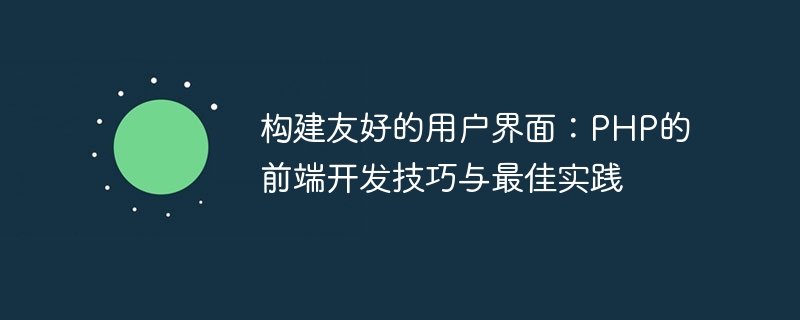Home >Backend Development >PHP Tutorial >Building a user-friendly interface: PHP front-end development tips and best practices
Building a user-friendly interface: PHP front-end development tips and best practices
- WBOYWBOYWBOYWBOYWBOYWBOYWBOYWBOYWBOYWBOYWBOYWBOYWBOriginal
- 2023-09-12 13:04:431139browse

Building a friendly user interface: PHP front-end development skills and best practices
In today’s era of popular Internet, the user interface is the face of a website or application , which directly affects user experience and acceptance. As a popular back-end development language, PHP also plays an important role in front-end development. This article will introduce some tips and best practices for PHP front-end development to help developers build friendly user interfaces.
1. Use responsive design
With the popularity of mobile devices, it is crucial to ensure that a website or app displays well on a variety of screen sizes. Responsive design is a development method that adapts to different screen sizes. In front-end development of PHP, various CSS frameworks (such as Bootstrap) can be used to help achieve responsive design. By using responsive design, you can provide your users with a consistent experience whether they are using your website or app on a computer, tablet, or mobile phone.
2. Optimize images and media files
Images and media files are indispensable elements of the user interface, but they are also often one of the main reasons why websites load slowly. To improve loading speed and experience for users, developers can optimize the size and format of images and media files. For example, you can use image compression tools to reduce file size and use the WebP format instead of traditional JPEG or PNG formats to reduce loading times. In addition, for some larger media files, you can consider using delayed loading or segmented loading technology to improve the page's response speed.
3. Proper use of front-end framework
Front-end framework is a tool that can help developers quickly build user interfaces. In front-end development of PHP, some popular front-end frameworks such as Vue.js and React can provide rich components and functions, allowing developers to build interactive and dynamic user interfaces more efficiently. However, developers should pay attention to reasonable choices when using front-end frameworks and avoid misuse, which can lead to overly bloated code and long page load times.
4. Follow web standards and accessibility principles
Following web standards is a good front-end development practice that helps ensure the consistency of websites and applications across different browsers and platforms and accessibility. Developers can write in appropriate HTML, CSS and JavaScript code and follow the corresponding web standards. Additionally, accessibility principles are an important aspect that ensure that websites and applications are accessible and usable by users with disabilities. Developers can improve the accessibility of user interfaces by using meaningful markup, providing appropriate descriptions, and keyboard navigation.
5. Test and optimize performance
The performance of the user interface directly affects the user experience and satisfaction. To ensure good user interface performance, developers should conduct adequate testing and optimization. There are tools and techniques you can use to evaluate page load times, reduce duplicate JavaScript and CSS code, merge and compress files, and more. In addition, developers can also use caching technology to improve page response speed, and be careful to avoid using too many third-party plug-ins and libraries to avoid affecting performance.
In short, front-end development in PHP is one of the key steps in building a user-friendly interface. By using techniques and best practices such as responsive design, optimizing images and media files, using front-end frameworks appropriately, following web standards and accessibility principles, and testing and optimizing performance, developers can provide users with a user-friendly, fast, and consistent experience. User interface experience. In the future development, as technology and user needs continue to change, PHP front-end development will continue to progress and evolve.
The above is the detailed content of Building a user-friendly interface: PHP front-end development tips and best practices. For more information, please follow other related articles on the PHP Chinese website!

